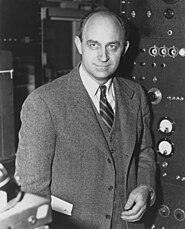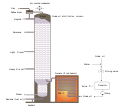
A | B | C | D | E | F | G | H | CH | I | J | K | L | M | N | O | P | Q | R | S | T | U | V | W | X | Y | Z | 0 | 1 | 2 | 3 | 4 | 5 | 6 | 7 | 8 | 9
| Main page | New articles & Tasks |
 The Energy Portal Welcome to Wikipedia's Energy portal, your gateway to energy. This portal is aimed at giving you access to all energy related topics in all of its forms.
|
Page contents: Selected article • Selected image • Selected biography • Did you know? • General images • Quotations • Related portals • Wikiprojects • Major topics • Categories • Help • Associated Wikimedia |
Introduction
In physics, energy (from Ancient Greek ἐνέργεια (enérgeia) 'activity') is the quantitative property that is transferred to a body or to a physical system, recognizable in the performance of work and in the form of heat and light. Energy is a conserved quantity—the law of conservation of energy states that energy can be converted in form, but not created or destroyed. The unit of measurement for energy in the International System of Units (SI) is the joule (J).
Common forms of energy include the kinetic energy of a moving object, the potential energy stored by an object (for instance due to its position in a field), the elastic energy stored in a solid object, chemical energy associated with chemical reactions, the radiant energy carried by electromagnetic radiation, and the internal energy contained within a thermodynamic system. All living organisms constantly take in and release energy.
Due to mass–energy equivalence, any object that has mass when stationary (called rest mass) also has an equivalent amount of energy whose form is called rest energy, and any additional energy (of any form) acquired by the object above that rest energy will increase the object's total mass just as it increases its total energy.
Human civilization requires energy to function, which it gets from energy resources such as fossil fuels, nuclear fuel, or renewable energy. The Earth's climate and ecosystems processes are driven by the energy the planet receives from the Sun (although a small amount is also contributed by geothermal energy). (Full article...)
Selected article
Most hydroelectric power comes from the potential energy of dammed water driving a water turbine and generator. The energy extracted from water depends on the volume and on the difference in height between the source and the water's outflow. Pumped storage hydroelectricity schemes produce electricity to supply high peak demands by moving water between reservoirs at different elevations. They currently provide the only commercially important means of grid energy storage. At times of low electrical demand, excess generation capacity is used to pump water back into the higher reservoir, from where it can be released through the turbines at short notice. Less common types of hydroelectricity include run-of-the-river, waterwheels, and tidal power schemes.
A major advantage of hydroelectricity is the elimination of fuel costs and the associated carbon emissions although, in tropical regions, decaying plant material behind the dam can sometimes result in greater greenhouse gas emissions than a conventional power station. Other issues include the need to relocate people from areas to be flooded and disruption caused to aquatic ecosystems.
Selected image

Photo credit: Andreas Tille
Geysers erupt periodically due to surface water being heated by geothermal heat.
Did you know?

- The Power of Community: How Cuba Survived Peak Oil is a documentary film which details Cuba's efforts to recover from the 1990s economic crisis known as the Special Period?
- The Geysers (pictured), north of San Francisco, California, is the largest geothermal power development in the world?
- The International Energy Agency was founded in 1974 by the Organisation for Economic Co-operation and Development (OECD) in the wake of the 1973 oil crisis?
- Indian Railways has started to use Jatropha oil, blended with diesel fuel in various ratios, to power its Diesel locomotives?
- The South Wales Gas Pipeline is the largest high pressure gas pipeline in the United Kingdom?
- The Presbyterian Church (USA) was the first major religious denomination in the world to call on its followers to become carbon neutral?
- There was partial meltdown at the Three Mile Island nuclear power plant in 1979?
- A hybrid electric vehicle achieves better fuel economy than a conventional vehicle without being hampered by the limited range of an electric vehicle?
Selected biography
Fermi was well-known for his simplicity in solving problems. Whenever possible, he avoided complicated mathematics and obtained quick results based on order of magnitude estimates. Fermi also meticulously recorded his calculations in notebooks, and later used to solve many new problems that he encountered based on these earlier known problems.
After accepting the 1938 Nobel Prize in Stockholm, Fermi immigrated to New York with his family to escape the anti-Semitic laws of Fascist Italy, as his wife Laura was Jewish.
After working at Columbia University, Fermi went to the University of Chicago and began studies that led to the construction of the world's first nuclear reactor Chicago Pile-1 (CP-1). The first artificial, self-sustaining, nuclear chain reaction was initiated within CP-1, on December 2, 1942.
In the news
- 1 June 2024 – Russian invasion of Ukraine
- Russia launches missile and drone strikes across Ukraine, injuring at least four people and damaging critical infrastructure, including energy facilities. Ukraine says that it shot down 35 of 53 missiles and 46 of 47 drones. (Reuters)
General images
Quotations
- "We must not waste time and energy disputing the IPCC's report or debating the right machinery for making progress. The International Panel's work should be taken as our sign post: and the United Nations Environment Programme and the World Meteorological Organisation as the principal vehicles for reaching our destination." – Margaret Thatcher, 1990
- "The Kyoto treaty would have wrecked our economy, if I can be blunt." – George W. Bush, 2005
- "We strongly believe that the efforts needed to combat climate change do not have to be regarded as constraints on the economy. Instead, they can be used as a lever for new, green technology." – Maud Olofsson, 2007
Related portals
WikiProjects
WikiProjects connected with energy:
Other WikiProjects that may be of interest:































































































































































